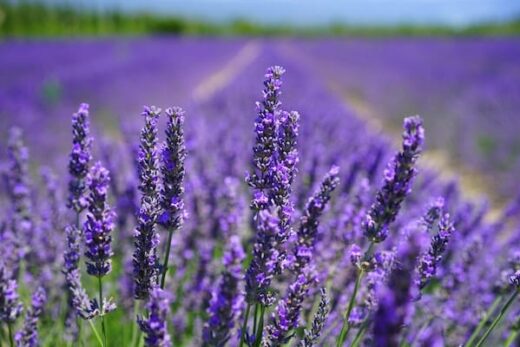
Once used by the Romans for its fragrance and therapeutic properties. Today, lavender is one of the most popular medicinal plants in phytotherapy. Particularly in the treatment of nervousness, digestive and joint disorders.
Description of lavender
Lavender is a shrub about 30 to 60 cm tall, with slender branches and small, pointed leaves at the base only. A member of the Lamiaceae family, lavender flowers range from blue to a soft violet. The plant is best grown in well-drained, rocky, calcareous soil with plenty of sunshine. Lavender, with its pleasant scent, is much loved by bees. Three types of lavender are frequently used for their therapeutic effects: Aspic lavender, true or officinal lavender and lavandin. They all have different properties and are used in different ways.
Lavender in Phytotherapy
Lavender plays an important role in phytotherapy. Its exceptional essential oil composition makes it a highly prized plant in aromatherapy, used to soothe and treat skin ailments. The flowering tops of lavender are used in phytotherapy. The flowers can produce two derivatives: essential oil and cryo-ground total powder. In alternative medicine, lavender supplements are mainly used as a calming agent, to treat nervousness or anxiety.
The virtues of lavender in alternative medicine
Lavender can be used both internally and externally. It’s important to use it properly, as its properties vary according to the mode.
External use
Lavender can be used externally to treat a wide range of ailments, either as a massage or a bath.
● For the treatment of skin problems such as superficial burns, eczema, acne, insect bites and infected wounds.
● To relieve blood circulation problems
● To soothe rheumatic pain
● Against viper bites (anti-venomous)
● To treat lice (anti-parasite)
Tip for use:
Add 1 to 4 drops of lavender essential oil to 1 tablespoon of vegetable oil, to obtain a homogeneous mixture. Gently massage the affected part of the body with this preparation, up to 3 times a day.
Internal use
Lavender can be infused (dried flowers) or used as an oil. When used internally, it has soothing and well-being effects, including :
● To treat sleep disorders,
● Anti-spasmodic effect, thanks to the esters contained in the plant.
● For digestive problems or ulcers
● To relieve respiratory infections such as colds, sinusitis or asthma
● To treat migraines, nausea or dizziness
● To reduce stress, nervous disorders and anxiety
● Against the effects of mild depression
● To relieve muscle cramps or pain
● To treat high blood pressure.
Tip for use:
Infuse around 1.5 g of dried lavender for at least 10 minutes in 150 ml of boiling water. You can drink this concoction up to 3 times a day, to combat insomnia and nervous disorders.
Follow us on Facebook and Instagram for daily health tips and advice, or attend our next free event near you by calling 01 87 64 35 43 to reserve your place.
Discover our other articles on our blog: click here.